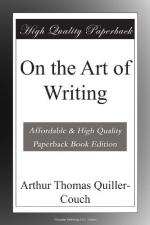Next, having trained yourself to keep a look-out for these worst offenders (and you will be surprised to find how quickly you get into the way of it), proceed to push your suspicions out among the whole cloudy host of abstract terms. ‘How excellent a thing is sleep,’ sighed Sancho Panza; ’it wraps a man round like a cloak’—an excellent example, by the way, of how to say a thing concretely: a Jargoneer would have said that ’among the beneficent qualities of sleep its capacity for withdrawing the human consciousness from the contemplation of immediate circumstances may perhaps be accounted not the least remarkable.’ How vile a thing—shall we say?—is the abstract noun! It wraps a man’s thoughts round like cotton wool.
Here is a pretty little nest of specimens, found in “The Times” newspaper by Messrs. H. W. and F. G. Fowler, authors of that capital little book “The King’s English":—
One of the most important reforms mentioned in the rescript is the unification of the organisation of judicial institutions and the guarantee for all the tribunals of the independence necessary for securing to all classes of the community equality before the law.
I do not dwell on the cacophony; but, to convey a straightforward piece of news, might not the Editor of “The Times” as well employ a man to write:—
One of the most important
reforms is that of the Courts, which need
a uniform system and
to be made independent. In this way only can
men be assured that
all are equal before the law.
I think he might.
A day or two ago the musical critic of the “Standard” wrote this:—
MR LAMOND IN BEETHOVEN
Mr Frederick Lamond, the Scottish pianist, as an interpreter of Beethoven has few rivals. At his second recital of the composer’s works at Bechstein Hall on Saturday afternoon he again displayed a complete sympathy and understanding of his material that extracted the very essence of aesthetic and musical value from each selection he undertook. The delightful intimacy of his playing and his unusual force of individual expression are invaluable assets, which, allied to his technical brilliancy, enable him to achieve an artistic triumph. The two lengthy Variations in E flat major (Op. 35) and in D major, the latter on the Turkish March from ‘The Ruins of Athens,’ when included in the same programme, require a master hand to provide continuity of interest. To say that Mr Lamond successfully avoided moments that might at times, in these works, have inclined to comparative disinterestedness, would be but a moderate way of expressing the remarkable fascination with which his versatile playing endowed them, but at the same time two of the sonatas given included a similar form of composition, and no matter how intellectually brilliant may be the interpretation, the extravagant use of a certain mode is bound in time to become somewhat ineffective. In the Three Sonatas, the E major (Op. 109), the A major (Op. 2), No. 2, and the C minor (Op. 111), Mr Lamond signalised his perfect insight into the composer’s varying moods.
Will you not agree with me that here is no writing, here is no prose, here is not even English, but merely a flux of words to the pen?




